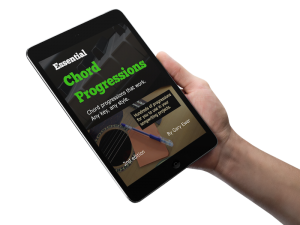It used to be that “repeat-and-fade” was the most common way to end a pop song. There was something nice about it — a sense of “riding off into the sunset” that had the effect of making you feel that the song was still out there somewhere.
These days, repeat-and-fade is a lot less common. It’s hard to know why that is, but repeat-and-fade is a kind of stylistic production-level decision, and styles come and go. Perhaps decisions that make live performance easier has had something to do with it: you can’t easily do a repeat-and-fade live.
 If you’re ready to take your songwriting to its highest level possible, you need “The Essential Secrets of Songwriting 10-eBook Bundle.” Get the manuals that thousands of songwriters are using. Comes with a Study Guide.
If you’re ready to take your songwriting to its highest level possible, you need “The Essential Secrets of Songwriting 10-eBook Bundle.” Get the manuals that thousands of songwriters are using. Comes with a Study Guide.
This week on the Billboard Hot 100, only two of the top ten songs use a repeat-and-fade ending. That means for the others, an actual ending needed to be created. I say “created”, but in fact most songs end by simply stopping, with no particular ending necessary.
In “Levitating” (Dua Lipa, et al), the repeating chord progression that ends on the tonic chord — Bm-F#m-Em-Bm (i-v-iv-i) — gives it a convenient and satisfying spot to do an abrupt stop. But as you likely know, these days it’s fine to simply stop anywhere, no matter what chord is being played. Bieber’s “Holy” ends mid-phrase on an implied IV-chord.
So if it seems that you can end a song in pretty much any way you like, how important should creating an ending be to your songwriting process?
The honest answer is: probably not very.
Comparing the thought that should go into how you start a song to how you finish it, there can be no doubt that starting a song is far more vital to grabbing and keeping an audience. For most songs, you only get a very few seconds before a listener might make the decision to click away from your song to someone else’s.
But ending it? You’ve really got just a few options:
- Repeat-and-fade (might make your song sound a bit dated, so be careful).
- End right at the last word of the chorus, regardless of the chord. (There’s no need to feel you have to end on a tonic chord.)
- Create a true coda — an ending that is different from everything else in the song, the sole purpose of which is to give the listeners something satisfyingly final.
If you really want to research this to come up with good endings for your songs, one of the best ways is to look back a few decades ago, especially in the 70s, which was arguably repeat-and-fade’s heyday, and then look for a live rendition by that performer on YouTube. No doubt the band will have created an ending to replace the repeat-and-fade that was on the studio recording.
The live version of Eagles’ “Hotel California” does a little rhythmic pattern on the final chord to bring it to a quick and satisfying close. America does something similar for their live version of “Ventura Highway” — simply stopping on the final tonic chord.
Sometimes the band comes up with an entirely new ending for the repeat-and-fade of the studio version, like Chicago’s “Beginnings” live version.
So as you can see, though there may not be all that many ways to end a song, the good news is that it isn’t usually going to make or break your tune. There’s no ending I can think of where I’ve felt that it damaged a song.
But having said that, it may be like most other musical effects you might use for your songs: making the same choice for every song is probably not the way to do. Use your imagination!
 Written by Gary Ewer. Follow Gary on Twitter.
Written by Gary Ewer. Follow Gary on Twitter.
 If all you need to get the songwriting process working is a good chord progression, “The Essential Secrets of Songwriting 10-eBook Bundle” includes several eBooks with long lists of progressions you can use as is, or modify for your own songs. Check out the bundle today!
If all you need to get the songwriting process working is a good chord progression, “The Essential Secrets of Songwriting 10-eBook Bundle” includes several eBooks with long lists of progressions you can use as is, or modify for your own songs. Check out the bundle today!










